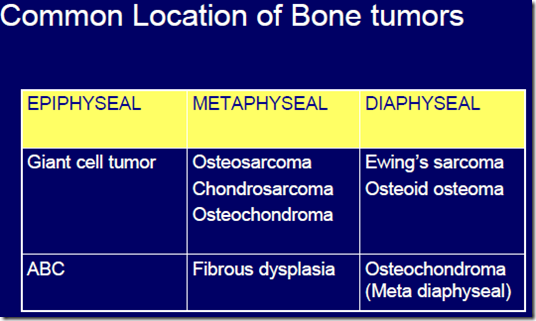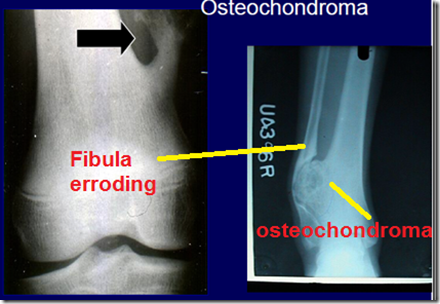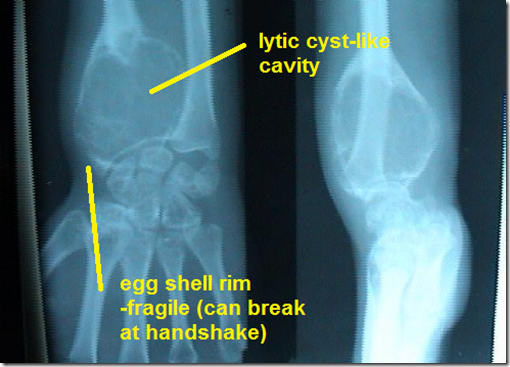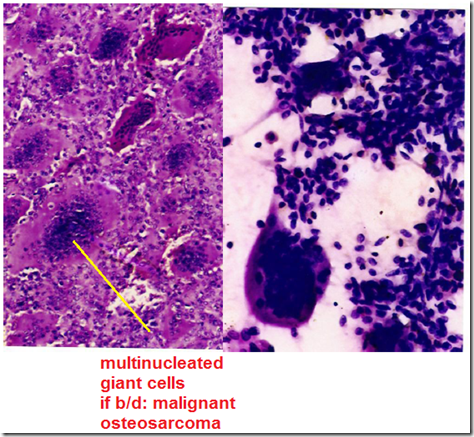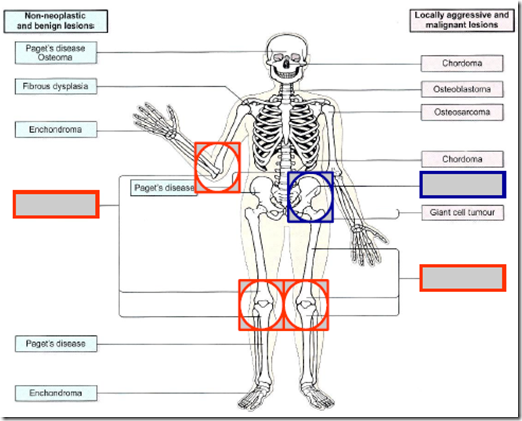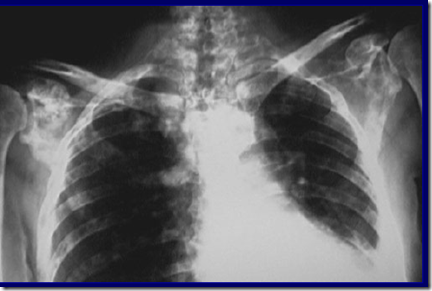Osteomyelitis
- Definition: Inflammation of the bone & marrow
- Challenging to treat
- less choice of effective antibiotics
- less penetrance of antibiotics into the bone
- infection will lead to disability/morbidity!
- viruses
- bacteria
- parasites
- fungi
2 types of osteomyelitis
- Pyogenic osteomyelitis (Acute)
- Infection reach bone by
- Hematogenous spread (most common)
- Extension from contiguous site
- Direct implantation
- Microorganisms
- Staphylococcus Aureus (most common)
- UTI & IV drug abusers
- E. Coli
- Pseudomonas
- Klebsiella
- Haemophilus influenza
- children
- Salmonella
- sickle cell anemia
- Pathophysiology
- On Location:
- infection reaches metaphysis
- bacteria proliferates
- causing bone death
- Sequestrum: piece of dead bone
- bone necrosis
- causing bone death
- sub-periosteal abscess formation
- lifts the periosteum
- further impair the blood supply
- Rupture of Periosteum
- abscess in surrounding soft tissue
- Sinus formation
- to drain fluid
- Host response:
- Release cytokines from leukocytes
- stimulate osteoclastic bone resorption
- Fibrous tissue formation
- Reactive bone deposition in periphery
- Forms a sleeve of new viable bone
- Involucrum: new bone
- Release cytokines from leukocytes
- On Location:
- Clinical course
- Acute systemic illness
- Pain
- Tenderness
- Immobility
- Xray
- Lytic focus of bone destruction
- Followed by zone of sclerosis
- Blood culture
- can be +ve
- Biopsy
- invasive
- confirms the diagnosis
- Acute systemic illness
- Complications
- Pathological fracture
- Secondary amyloidosis
- Endocarditis
- Sepsis
- Sinus tract squamous cell carcinoma (rare)
- Epiphyseal infection
- Joint cartilage is rigid
- last to get infected
- infection spreads to articular surface
- spreads to joint capsule
- suppurative/septic arthritis
- lead to extensive destruction of articular cartilage
- permanent disability
- Joint cartilage is rigid
- Infection reach bone by
- Mycobacterial/Tuberculous osteomyelitis (Chronic)
- 1-3% of TB cases
- Infection sites:
- Ribs
- direct involvement
- Vertebrae
- from lymphatic drainage
- common in thoracic & lumbar vertebrae
- Ribs
- Spine TB: Pott’s spine
- Infection breaks through intervertebral disc
- involve vertebrae & soft tissue
- forming abscesses
- Infection breaks through intervertebral disc
- Complications
- Psoas abscess formation
- Compression fracture
- of the vertebrae
- Scoliosis or kyphosis
- Spinal cord compression
- neurological deficits
- TB arthritis
- Abscess
- Sinus tract formation
_____________________________________________________________
Bone tumours
- Rare
- 40% malignant
- Aetiology
- No obvious cause (usually)
- Ionising radiation
- Predisposing conditions:
- Paget’s disease
- Fibrous dysplasia
- Retinoblastoma
- genetic
- Syndromes
- Gardner’s
- Ollier’s disease
Category/Classification
- Primary
- Bone-producing tumours
- Osteoid osteoma
- Osteoblastoma
- paediatric
- Osteosarcoma*
- Cartilage-producing tumours
- Osteochondroma*
- Chondroma (enchondroma)
- Chondrosarcoma*
- Miscellaneous tumors
- Ewing’s sarcoma*
- Giant cell tumor of bone*
- Secondary
- Metastases
- Tumour-like bone tumour (mimicry)
- Bone cysts
- Simple bone cyst
- Aneurysmal bone cyst
- Fibrous-osseous lesion
- Fibrous dysplasia
- Eosinophilic granuloma
- Langerhans histiocytosis
_____________________________________________________________________
Primary (more common in the young)
Osteosarcoma

Codman’s triangle & Sunburst appearance in Osteosarcoma


Osteosarcoma – spread towards cortex
- Because bone is a CT
- most common primary tumour
- young adults (10-25 yo)
- rare in later age, due to secondary causes
- Genetic
- mutations to RG gene
- Morphology
- Location
- metaphysis of long bone
- around knee
- tibia, fibula
- In old age
- flat & long bones
- Anatomical portion of bone
- Intramedullary
- most common
- tumour can break through cortex
- Intracortical
- Surface
- good prognosis
- Gross
- Form bulky tumours
- Gritty, gray white, yellowish mass
- Invasion to surrounding tissues
- Infiltrate the medullary canal & spread towards cortex
- epiphyseal penetration is rare
- Joint invasion
- later stages
- Microscopy
- Tumour cells are osteoblastic cells
- histologic variants:
- osteoblastic
- chrondroblastic
- small cell
- Formation of lacy osteoid by tumour cells
- Variation in size, shape
- bizarre features
- Tumour giant cells
- Hyperchromatism
- Mitiosis
- Binucleation
- Vascular & blood vessels invasion
- Xray
- large destructive mass lesion
- mixed lytic & sclerotic areas
- Elevation of periosteum
- Codman’s triangle
- Sunburst appearance
- spread of tumour into surrounding soft tissue
_____________________________________________________________________
Osteochondroma
- Cartilage covered by bony excrescense (exostosis)
- formation of new bone on surface of bone
- Can be solitary or multiple
- Spontaneous
- Location
- metaphysis
- diaphysis
- Morphology
- painless skeletal swelling
- slowly growing mass
- palpable bony masses
- Complications
- can lead to limb shortening
- when bone is still actively growing
- 1st – 2nd decade of life
- fractures
- bone deformities
- neurologic/vascular injuries
- bursa formation
- malignant transformation
- rare
- Osteochondromatosis
- autosomal dominant condition
- short stature
- multiple osteochondroma
- located close to metaphysis
- sessile or pedunculated
- cortex of lesion continuous with cortex of bone
- with a homogenous continuation of the medulla
- asymmetric growth
- knees
- ankles
- may lead to deformities
_____________________________________________________________________
Chondrosarcoma

Chondrosarcoma – affects axial skeleton

Chondrosarcoma – affecting the finger
- 2nd most common malignant primary bone tumour
- older adults
- 30-60 yo
- can arise from previous enchondroma
- many are sporadic
- location
- axial skeleton
- pelvis
- pectoral girdles
- ribs
- spine
- Aggressive
- erodes & invades soft tissue
- *Metastasize to: (suspect chondrosarcoma)
- lungs
- liver
- kidney
- brain
- Gross
- large bulky tumours
- grey white, translucent
- Microscopy
- malignant cartilage
- with anaplastic chondrocytes in spaces
- focal enchondral ossification & calcification
- hypercellularity, atypia, mitosis
- Treatment
- resistant to chemotherapy
- therefore must be surgical resection
_____________________________________________________________________
Giant cell tumour of bone (Osteoclastoma)
- Osteoclastoma
- potentially malignant
- mostly benign
- arise in epiphysis
- develop after fusion of cartilage
- after epiphyseal plate thins out
- lytic lesion at end of bone
- knee
- elbow
- ankle
- Treatment
- resection
- recurrence is common
- Pathology
- osteoclastic giant cells
- 100 or more nuclei
- nuclei similar to those of stromal cells
- giant cells are not malignant
- mesenchymal cells
- ovoid
- mononuclear cells
- Haemorrhage and necrosis present
_____________________________________________________________________
Secondary (metastatic)
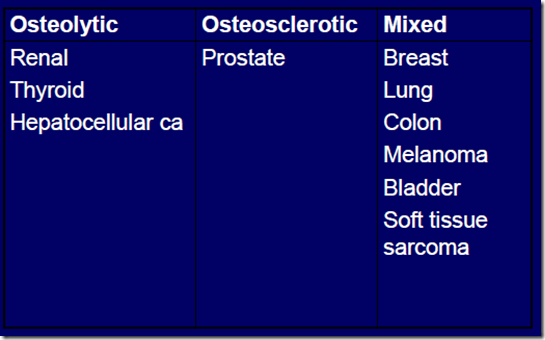 Looking at the pattern of bone lesion, you should also screen for these primary cancer sites
Looking at the pattern of bone lesion, you should also screen for these primary cancer sites
- more common in the old
- most commmon malignant tumour in skeleton
- metastasize from:
- breast tumour
- kidney tumour
- thyroid
- lung
- Generally occur in
- vertebrae
- pelvis
- if primary tumour from pelvis, can spread to lumbosacral spine
- proximal parts of the
- femur
- humerus
- ribs
- skull
- Rare
- hands
- feet
- Marrow neoplasm (hemopoietic):
- myeloma
- leukemia
- lymphoma
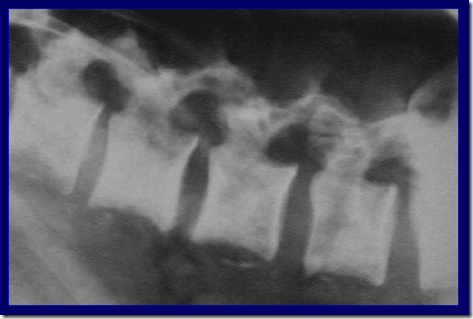
Mixed lytic and sclerotic lesion



